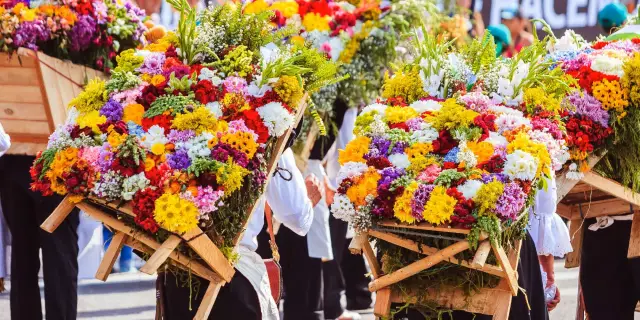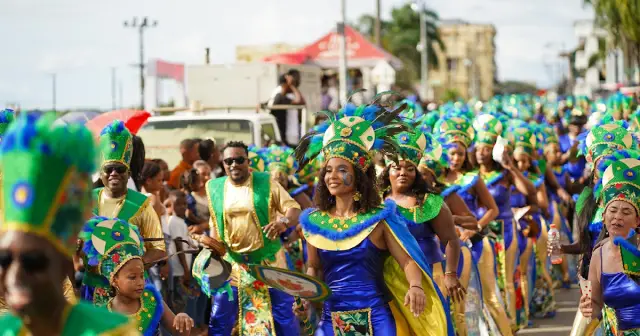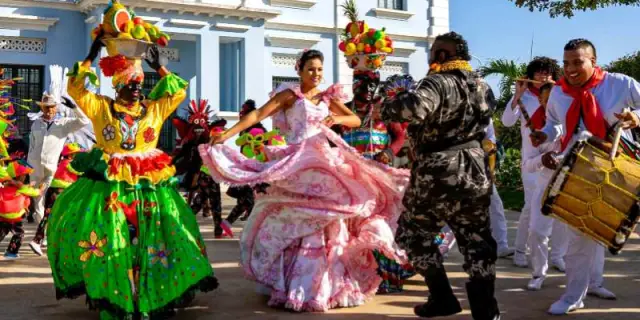Colombia is a country distinguished not only by its biodiversity and stunning landscapes, but also by its cultural richness, manifested in a wide variety of regional festivals. From the Caribbean coasts to the Andes Mountains and the Amazon rainforest, every corner of the country proudly celebrates its roots, traditions, and artistic expressions. Colombia's unique regional festivals, which you should experience, not only offer authentic and exciting experiences but are also an extraordinary way to immerse yourself in the heart of its cultural identity. Participating in these celebrations is an opportunity to see, hear, taste, and experience the Colombian soul in all its splendor.
Colombia's most representative regional festivals
Barranquilla Carnival – Atlántico (Caribbean)
The Barranquilla Carnival is one of the most renowned festivals in Latin America and one of Colombia's cultural prides. With African, Indigenous, and European roots, this celebration is experienced with unique intensity during the four days leading up to Ash Wednesday. It is a popular festival, where everyone participates, and the city is transformed into an open stage for music, dance, costumes, and color. Declared Oral and Intangible Heritage of Humanity, this carnival is the second largest in the world after Rio de Janeiro.
What you can't miss:
The Battle of Flowers, inaugural parade with spectacular floats and troupes.
The Grand Parade parade, featuring folk dances from all regions.
Traditional dances such as Congo, Garabato and Cumbia, a living heritage of Colombian mestizaje.
Flower Fair – Medellín (Antioquia)
Held in August, the Medellín Flower Fair is a tribute to the silleteros (flower bearers) of Santa Elena, who for decades have carried flowers on their backs as a symbol of work and beauty. This event is one of the most emblematic of Paisa culture, combining regional pride, floral art, music, and civic spirit. For over a week, the city literally blooms with cultural events for the whole family.
Featured events:
The Silleteros Parade, where more than 500 farmers display works of art made with flowers.
Concerts by national and international artists, from vallenato to reggaeton.
Flower shows, classic car parade, and craft markets.

Black and White Carnival – Pasto (Nariño)
In the city of Pasto, one of the country's most unique and symbolic festivals is celebrated every January: the Carnival of Blacks and Whites. This celebration represents the cultural fusion of the ethnic groups that make up southwestern Colombia, a tribute to freedom, inclusion, and collective joy. For several days, the streets are filled with color, music, foam, and fraternity.
Unique aspects:
Black People's Day, where participants wear blackface on a day of equality and coexistence.
Whites' Day, with talcum powder and white paint as a symbol of peace and harmony.
The monumental floats, crafted with impressive artistic techniques, travel through the city in an unforgettable parade.
Vallenato Festival – Valledupar (Cesar)
Vallenato is more than a musical genre: it's a cultural expression that tells stories of love, nostalgia, struggle, and everyday life. Every April, Valledupar becomes the epicenter of vallenato folklore, welcoming thousands of national and international visitors. The Vallenato Legend Festival brings together the best accordionists, composers, and singers in a vibrant and emotional competition.
Main activities:
Vallenato King Contest in various categories (amateur, children's, professional).
Parades of piloneras, typical dances of Cesar.
Caribbean cuisine, such as chicken sancocho, cheese arepa, and butifarra.
San Pacho Festival – Quibdó (Chocó)
The Feast of Saint Francis of Assisi, known as San Pacho, is celebrated with Afro-Colombian fervor in Quibdó, the capital of Chocó. This religious and cultural festival reflects the syncretism of the Catholic faith with African traditions and is an intense, spiritual, and festive experience. For nearly two weeks, the city is transformed by drums, dances, parades, and rhythmic masses.
Traditional elements:
Colorful groups that travel through neighborhoods and communities, each with a theme.
Liturgical celebrations accompanied by native music and praises.
River processions on the Atrato River, in decorated boats.

Lesser-known but unmissable festivities
Bambuco Festival – Neiva (Huila)
In the heart of the Magdalena Valley, Neiva celebrates the Bambuco Festival and National Pageant every June. This event celebrates the Andean traditions of Huila, especially through the Sanjuanero Huilense dance, an elegant dance that symbolizes peasant procession.
Theater Festival – Manizales (Caldas)
Founded in 1968, this international theater festival is one of the oldest in Latin America. It attracts theater, dance, and performance companies from around the world, filling the theaters, streets, and parks of Manizales with performance art for a week in January.
Sea Festival – Santa Marta (Magdalena)
This celebration combines the best of the Caribbean Sea with Santa Marta traditions. In July, Santa Marta offers nautical competitions, craft fairs, beach concerts, and the election of the Captain of the Sea, the city's tourism ambassador.
Why visit these festivities?
Each holiday in Colombia represents a unique opportunity to explore the many facets of the national culture. These celebrations allow visitors to experience the country's diverse and vibrant character through its dances, music, flavors, and rituals. Furthermore, attending a regional festival is not only entertaining but also contributes to responsible and sustainable tourism by supporting local communities, artists, and entrepreneurs.
Tips to enjoy these festivities to the fullest
Book in advance , especially if the holiday attracts thousands of tourists.
Check the local weather and dress appropriately; many festivals are held outdoors.
Dress for the occasion , some celebrations have dress codes or traditional costumes.
Respect local traditions and norms , some festivals have important religious or symbolic components.
Try the typical gastronomy , it is an essential part of the cultural experience.
Frequently Asked Questions (FAQ)
When is the best time to visit Colombia for its festivities?
It depends on the region. January (Carnival of Blacks and Whites), February (Barranquilla Carnival), and August (Flower Festival) are key months.
Is it safe to attend these celebrations?
Yes, many have safety plans for tourists. It's recommended to follow local guidelines and avoid remote areas without a guide.
What to wear to a regional festival in Colombia?
Comfortable clothing, sunscreen, a camera, cash, and a desire to have fun. Some events may require costumes or traditional attire.
Are the festivities free?
Many public activities are, but special events such as concerts or parades may have a cost.
